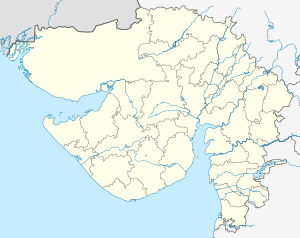Vadnagar railway station
This article includes a list of references, related reading, or external links, but its sources remain unclear because it lacks inline citations. (October 2019) |
| Vadnagar | |||||
|---|---|---|---|---|---|
| Indian Railways station | |||||
| General information | |||||
| Location | Vadnagar, Gujarat India | ||||
| Coordinates | 23°47′03″N 72°38′00″E / 23.784104°N 72.633333°E | ||||
| Elevation | 156 metres (512 ft) | ||||
| Owned by | Indian Railways | ||||
| Operated by | Western Railway | ||||
| Line(s) | Mahesana–Taranga Hill line | ||||
| Platforms | 2 | ||||
| Tracks | 4 | ||||
| Connections | Auto stand | ||||
| Construction | |||||
| Structure type | Standard (on ground station) | ||||
| Parking | no | ||||
| Bicycle facilities | no | ||||
| Other information | |||||
| Station code | VDG | ||||
| Zone(s) | Western Railway | ||||
| Division(s) | Ahmedabad railway division | ||||
| History | |||||
| Opened | 21/03/1997[citation needed] | ||||
| |||||
Vadnagar Railway Station is a railway station in Mehsana district, Gujarat. Its code is VDG. It serves Vadnagar town. The station consists of two platforms that was completed in 1963 December.
In the year 1880, the Government of Bombay addressed His Highness’ Government for the construction of feeder lines in Kadi after the completion of Dabhoi Railway. The Government of India sanctioned Mehsana Viramgam line in 1889. In Kadi, a network of railway line was spread out. The Mehsana–Taranga Hill metre-gauge line was opened for traffic from 1887 to 1909. In 1887, Mehsana Taranga line was opened. The line was 57 km. in length. In 1887, a survey was carried out for the extension on Kheralu branch on Vijapur. Mehsana Vadnagar line was opened to traffic in 1887 and Vadnagar to Kheralu and Kheralu to Taranga Hill was opened in 1909. On Mehsana–Taranga line there were nearly nine stations.
It also states that Mehasana Badnagar train starts from 21 March 1887, with only 1 train operating the whole day. It was a goods train with 2 halts and no junction linkages.
References
- http://shodhganga.inflibnet.ac.in/bitstream/10603/59850/8/08_chapter%204.pdf
- https://abn397.wordpress.com/2015/01/25/the-real-and-the-false-modinagar/


